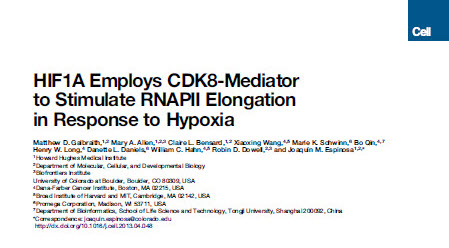 Every scientific paper is the story of a journey from an initial hypothesis to a final conclusion. It may take months or years and consists of many steps taken carefully one at a time. The experiments are repeated, the controls verified, the negative and positive results analyzed until the story finally makes sense. Sometimes the end of the story confirms the hypothesis, sometimes it is a surprise. A paper published last week in Cell describes a study where a team of researchers investigating one problem in basic biology (how one component of a signaling complex works), found an unexpected and potentially significant application in a different field (cancer research).
Every scientific paper is the story of a journey from an initial hypothesis to a final conclusion. It may take months or years and consists of many steps taken carefully one at a time. The experiments are repeated, the controls verified, the negative and positive results analyzed until the story finally makes sense. Sometimes the end of the story confirms the hypothesis, sometimes it is a surprise. A paper published last week in Cell describes a study where a team of researchers investigating one problem in basic biology (how one component of a signaling complex works), found an unexpected and potentially significant application in a different field (cancer research).
The paper, published in the June 6 issue of Cell, describes a previously unknown interaction between two cellular proteins—the transcription factor HIF1A and the cyclin-dependent kinase CDK8—in the regulation of genes associated with cellular survival under low-oxygen conditions. An accompanying press release describes how the discovery of a role for CDK8 in this process may have implications for cancer research, as CDK8 may be a potential target for drugs to combat “hypoxic” tumors.
Hypoxia occurs when a tumor outgrows its blood supply and the cells within the tumor are subjected to a low-oxygen environment. Hypoxic tumors are associated with negative outcomes, showing resistance to treatment and a greater likelihood to metastasize. Cells within the tumor respond to low-oxygen environments by expressing numerous genes that enable survival under these conditions. The transcription factor HIF1A is a known oncogene that plays a key role in this cellular response to hypoxia; however, attempts to develop anti-cancer drugs targeting HIF1A have so far been unsuccessful, and the specific mechanism whereby HIF1A interacts with RNA polymerase II to activate transcription of hypoxia-regulated genes is poorly understood.
In the press release, the corresponding author—Joaquin Espinosa from the University of Colorado—describes the discovery of the relationship between HIF1A and CDK8 and the subsequent connection to cancer research as “serendipidious”. The researchers did not set out to study cellular responses to hypoxia but instead to investigate the basic biology of gene regulation—specifically seeking to identify the role of the kinase CDK8 in a regulatory protein complex known as Mediator. Mediator is a large multipart signaling molecule that interacts with many cellular components including chromatin, transcription factors and RNA polymerase II. Several of the components of Mediator, including CDK8, have undergone gene duplication to generate pairs of molecules known as paralogs. CDK8 and its paralog CDK19 are optional components of the Mediator complex. The researchers sought to identify the function of CDK8 in this context.
Initially the authors transfected a colorectal cancer cell line that expressed both CDK8 and CDK19 with HaloTag fusion constructs of CDK8 or CDK19 and used these in a pulldown assay to identify proteins that interact with CDK8 or CDK19. These experiments showed that Mediator complexes contained either CDK8 or CDK19, but not both. They then used microarray analysis of cells where expression of either CDK8 or CDK19 was knocked down to identify how these molecules affect gene expression profiles. They also subjected the knockdown cells to various stress stimuli, one of which was hypoxia, and evaluated expression profiles under stress conditions. At this point the initial connection between CDK8 and the cellular response to hypoxia became apparent.
Next, the researchers investigated whether CDK8 is a coactivator for HIF1A, using qRT-PCR to analyze the effect of CDK8 knockdown or HIF1A knockdown on the hypoxia-related genes they had shown to be regulated by CDK8. The results showed that Hif1A was required for induction of most of the CDK8-regulated genes. They then used a variety of ChIP assays to unravel the many complex relationships between hypoxic conditions, binding of CDK8 to regulatory sequences upstream of hypoxia (and HIF1A)-regulated genes, HIF1A recruitment, and RNA polymerase II activation. Ultimately, they were able to determine that HIF1A acts through CDK8 to enable cells to react to hypoxic environments—and in so doing identified previously unknown interactions between CDK8, HIF1A, and RNA polymerase II that result in initiation of transcription.
The result is exciting for cancer research because of the potential to target CDK8 with kinase inhibitors—an existing class of drugs.
Here’s the press release.
And Here’s the Paper:
![]() Galbraith, M., Allen, M., Bensard, C., Wang, X., Schwinn, M., Qin, B., Long, H., Daniels, D., Hahn, W., Dowell, R., & Espinosa, J. (2013). HIF1A Employs CDK8-Mediator to Stimulate RNAPII Elongation in Response to Hypoxia Cell, 153 (6), 1327-1339 DOI: 10.1016/j.cell.2013.04.048
Galbraith, M., Allen, M., Bensard, C., Wang, X., Schwinn, M., Qin, B., Long, H., Daniels, D., Hahn, W., Dowell, R., & Espinosa, J. (2013). HIF1A Employs CDK8-Mediator to Stimulate RNAPII Elongation in Response to Hypoxia Cell, 153 (6), 1327-1339 DOI: 10.1016/j.cell.2013.04.048
Isobel Maciver
Latest posts by Isobel Maciver (see all)
- 3D Cell Culture Models: Challenges for Cell-Based Assays - August 12, 2021
- Measuring Changing Metabolism in Cancer Cells - May 4, 2021
- A Quick Method for A Tailing PCR Products - July 8, 2019
